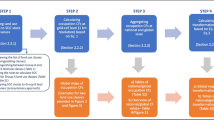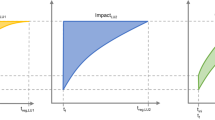Abstract
Purpose
Improving land use assessment in life cycle assessment (LCA) is a priority. Recently, soil organic carbon (SOC) depletion has been proposed as a transformation and occupation midpoint indicator to estimate impacts on biotic production potential (BPP). SOC depletion is recommended by the European Union in the International Reference Life Cycle Data System (ILCD) Handbook as a land use indicator. There is a consensus method to calculate SOC depletion in LCA, and ILCD proposes a set of characterization factors (CFs), but these lack geographical discrimination.
Methods
Our method of calculation for midpoint CFs follows Brandão and Milà i Canals (Int J Life Cycle Assess 18:1243–1252, 2013). We operationalize the method using SOC stocks from the LUCASOIL database of field measurements in Europe. We use potential natural vegetation (PNV) as the reference situation. CFs were calculated on a cell basis for 23 countries in Europe and grouped in three spatial scales (an administrative classification, NUTS II, and two biophysical classifications, ecoregion and climate region) according to soil type and land cover following a consensus map of cover classes. To evaluate the method’s results, CFs were applied in a case study.
Results and discussion
SOC stocks of European soils were obtained according to land use and soil type classes (excluding non-European Union countries) for the three spatial scales. A database of European transformation and occupation CFs is also presented and analyzed. The aggregation of CFs at biophysical scales (ecoregion and climate region) is similar, but NUTS II aggregation of CFs is problematic. The application of the CFs in the case study revealed significant differences compared to the outcome of using CFs collected from other land use models.
Conclusions
This paper is the first operationalization using field measurements of an updated version of the ILCD-recommended model for land use impacts in LCA. We obtained CFs for SOC depletion in Europe that can be nested within CFs suggested by ILCD since our results possess better spatial resolution but are only for European Union countries. The case study application highlighted the need for inventories to improve the spatial resolution of the life cycle processes to match the detail of LCIA models.









Similar content being viewed by others
References
Alvarenga RAF, Dewulf J, Van Langenhove H, Huijbregts MAJ (2013) Exergy-based accounting for land as a natural resource in life cycle assessment. Int J Life Cycle Assess 18:939–947
Alvarenga RAF, Erb K-H, Haberl H et al (2015) Global land use impacts on biomass production—a spatial-differentiated resource-related life cycle impact assessment method. Int J Life Cycle Assess 20:440–450
Bot A, Benites J (2005) The importance of soil organic matter: key to drought resistant soil and sustained food and production. Food and Agriculture Organization of the United Nations (FAO), Rome
Brandão M, Milà i Canals L (2013) Global characterisation factors to assess land use impacts on biotic production. Int J Life Cycle Assess 18:1243–1252
Curran M, Hellweg S, Beck J (2014) Is there any empirical support for biodiversity offset policy? Ecol Appl 24:617–632
Don A, Schumacher J, Freibauer A (2011) Impact of tropical land-use change on soil organic carbon stocks - a meta-analysis. Glob Chang Biol 17:1658–1670
EC (2003) European soil database (distribution version v2.0)
European Commission - Joint Research Centre, Institute for Environment and Sustainability (2011) International Reference Life Cycle Data System (ILCD) Handbook - Recommendations for Life Cycle Impact Assessment in the European Context. Publications Office of the European Union, Luxemburg
Finkbeiner M, Ackermann R, Bach V et al (2014) Challenges in life cycle assessment: an overview of current gaps and research needs. In: Klöpffer W (ed) Background and future prospects in life cycle assessment. Springer Netherlands, Dordrecht, pp 207–258
Fischer G, Nachtergaele F, Prieler S, et al (2008) Global agro-ecological zones assessment for agriculture. http://www.iiasa.ac.at/Research/LUC/luc07/External-World-soil-database/HTML/index.html?sb=1
Garrigues E, Corson MS, Angers DA et al (2012) Soil quality in life cycle assessment: towards development of an indicator. Ecol Indic 18:434–442
Garrigues E, Corson MS, Angers DA et al (2013) Development of a soil compaction indicator in life cycle assessment. Int J Life Cycle Assess 18:1316–1324
Illies J (1978) Limnofauna Europaea. CRC Press, Stuttgart
IPCC (2003) Good Practice Guidance for Land Use, Land-Use Change and Forestry. Institute for Global Environmental Strategies (IGES) for the Intergovernmental Panel on Climate Change. The Intergovernmental Panel on Climate Change (IPCC), Kanagawa
IPCC (2006) 2006 IPCC Guidelines for National Greenhouse Gas Inventories. Institute for Global Environmental Strategies (IGES) for the Intergovernmental Panel on Climate Change. The Intergovernmental Panel on Climate Change (IPCC), Kanagawa
Jobbágy EG, Jackson RB (2000) The vertical distribution of soil organic carbon and its relation to climate and vegetation. Ecol Appl 10:423–436
Jolliet O, Frischknecht R, Bare J et al (2014) Global guidance on environmental life cycle impact assessment indicators: findings of the sco** phase. Int J Life Cycle Assess 19:962–967
Jones RJA, Hiederer R, Rusco E et al (2004) The map of organic carbon in topsoils in Europe, Version 1.2, September 2003: Explanation of Special Publication Ispra 2004 No.72 (S.P.I.04.72). European Soil Bureau Research Report No.17, EUR 21209 EN, 26pp. and 1 map in ISO B1 format. Office for Official Publications of the European Communities, Luxembourg
Koellner T, de Baan L, Beck T et al (2013) UNEP-SETAC guideline on global land use impact assessment on biodiversity and ecosystem services in LCA. Int J Life Cycle Assess 18:1188–1202
Mila Canals L, Baan L (2014) Land Use. In: Hauschild MZ, Huijbregts MAJ (eds) Life cycle impact assessment. Springer, Netherlands, pp 197–222
Milà i Canals L, Muñoz I, McLaren S, Brandão M (2007b) LCA Methodology and Modelling Considerations for Vegetable Production and Consumption. CES Working Papers 02/07
Milà i Canals L, Bauer C, Depestele J et al (2007) Key elements in a framework for land use impact assessment within LCA. Int J Life Cycle Assess 12:5–15
Morais TG, Teixeira RFM, Domingos T (2016) Regionalization of agri-food life cycle assessment: a review of studies in Portugal and recommendations for the future. Int J Life Cycle Assess. doi:10.1007/s11367-016-1055-3
Núñez M, Civit B, Muñoz P et al (2009) Assessing potential desertification environmental impact in life cycle assessment. Int J Life Cycle Assess 15:67–78
Núñez M, Antón A, Muñoz P, Rieradevall J (2012) Inclusion of soil erosion impacts in life cycle assessment on a global scale: application to energy crops in Spain. Int J Life Cycle Assess 18:755–767
Panagos P, Ballabio C, Yigini Y, Dunbar MB (2013) Estimating the soil organic carbon content for European NUTS2 regions based on LUCAS data collection. Sci Total Environ 442:235–246
Poeplau C, Don A, Vesterdal L et al (2011) Temporal dynamics of soil organic carbon after land-use change in the temperate zone - carbon response functions as a model approach. Glob Chang Biol 17:2415–2427
Ramankutty N, Foley JA (1999) Estimating historical changes in global land cover: croplands from 1700 to 1992. Global Biogeochem Cycles 13:997–1027
Reap J, Roman F, Duncan S, Bras B (2008) A survey of unresolved problems in life cycle assessment. Int J Life Cycle Assess 13:290–300
Saad R, Margni M, Koellner T et al (2011) Assessment of land use impacts on soil ecological functions: development of spatially differentiated characterization factors within a Canadian context. Int J Life Cycle Assess 16:198–211
Souza DM, Teixeira RFM, Ostermann OP (2015) Assessing biodiversity loss due to land use with life cycle assessment: are we there yet? Glob Chang Biol 21:32–47
Teixeira RFM (2015) Critical appraisal of life cycle impact assessment databases for agri-food materials. J Ind Ecol 19:38–50
Teixeira RFM, Domingos T, Costa APSV et al (2011) Soil organic matter dynamics in Portuguese natural and sown rainfed grasslands. Ecol Modell 222:993–1001
Tóth G, Jones A, Montanarella L (2013) The LUCAS topsoil database and derived information on the regional variability of cropland topsoil properties in the European Union. Environ Monit Assess 185:7409–7425
Tuanmu M-N, Jetz W (2014) A global 1-km consensus land-cover product for biodiversity and ecosystem modelling. Glob Ecol Biogeogr 23:1031–1045
Van-Camp L, Bujarrabal B, Gentile A-R et al (2004) Reports of the technical working groups established under the thematic strategy for soil protection. EUR 21319, 872 pp EN/3, Luxembourg
Acknowledgments
Work supported by a research grant of MARETEC Research Centre/Laboratory of Robotics and Systems in Engineering and Science/Instituto Superior Técnico/University of Lisbon. R. Teixeira was supported by grant SFRH/BPD/111730/2015 from Fundação para a Ciência e Tecnologia. We gratefully acknowledge the comments of two anonymous reviewers that helped improve the manuscript.
Author information
Authors and Affiliations
Corresponding author
Additional information
Responsible editor: Miguel Brandão
Electronic supplementary material
Below is the link to the electronic supplementary material.
ESM S1
SOC stock in European NUTS II, climate and eco regions according land cover and soil type and analyses of potential natural vegetation SOC (XLSX 104 kb)
ESM S2
Characterization factors (transformation and occupation) for the three geophysical scales (XLSX 94 kb)
ESM S3
Countries’ characterization factors (transformation and occupation) for the three geophysical scales aggregated by cells (bottom-up) and region (top-down) (XLSX 56 kb)
Rights and permissions
About this article
Cite this article
Morais, T.G., Domingos, T. & Teixeira, R.F.M. A spatially explicit life cycle assessment midpoint indicator for soil quality in the European Union using soil organic carbon. Int J Life Cycle Assess 21, 1076–1091 (2016). https://doi.org/10.1007/s11367-016-1077-x
Received:
Accepted:
Published:
Issue Date:
DOI: https://doi.org/10.1007/s11367-016-1077-x




